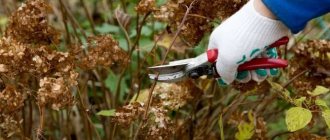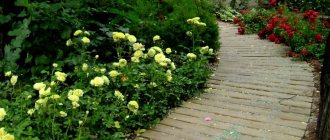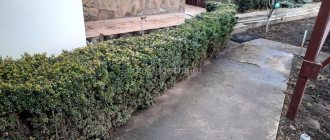Wrong lawn care in the fall and its illiterate preparation for winter may undo the fruits of years of effort. For years it was cared for and cherished, and then it was watered at the wrong time or incorrectly, fertilized in the wrong way, fallen leaves were left, and instead of a green lawn that caresses the eye, there is a risk of seeing brown bald spots. You will have to quickly sow new seeds on the wounded lawn and wait patiently until it takes on its previous appearance. But in the spring, every hour in the garden is precious. To prevent this from happening, you need to know how to care for your lawn in autumn.
Watering the lawn in winter
To prevent the lawn from withering and yellowing during dry weather in the fall, you need to take care of its watering:
- In the absence of rain, watering is carried out every 5–7 days using the sprinkling method. It is important to avoid overwatering, which can cause fungal diseases.
- In the first half of December, watering stops to prevent weakening of the root system.
Why is it needed?
Autumn lawn care is a must.
It is important because The condition of the grass in the summer depends on the implementation of competent measures. In addition, autumn care will allow the lawn to survive all the winter cold and bad weather. In spring it will again delight with its beautiful appearance.
The main goal of autumn lawn care is to strengthen the grass root system. The events do not include many stages , so dealing with them is not as difficult as it might seem. It is important to prepare your lawn for winter according to all the rules.
Lawn mowing
Depending on the time of year, turf needs to be mowed differently. The gardener must adapt to the climatic conditions that affect the growth of the grasses that make up the lawn. Mowing the lawn has more than just an aesthetic purpose. This operation also strengthens it and promotes root growth. Thus, the lawn is compacted by mowing, forming a dense carpet.
MOST READ FROM PARTNERS
In autumn, the lawn comes to life with frequent rains and mild temperatures. The mower resumes more regular maintenance with shorter cutting heights to promote good establishment before winter.
Do not mow below 3-4 cm in height, this will prevent the proper development of your turf and encourage the appearance of moss.
In autumn, the number of haircuts decreases with a decrease in soil temperature, as plants slow down their growth. But you shouldn’t completely give up mowing your lawn in the fall. It is necessary to monitor the weather forecast and carry out the last cutting 15 days before the onset of frost, so that the height of the grass before wintering does not exceed 7-8 cm.
After the lawn is well mowed, it is necessary to remove any mowing residue. Instead of throwing them away, it is better to compost them or better yet, mulch them for your ornamental plants. Mulching allows you to maintain soil moisture, at the same time limit the growth of weeds and fertilize the soil.
When is the last time to mow the lawn before winter?
Lawn grass goes through several stages of development before winter - from active growth on sunny autumn days to complete drying. The intensity of its growth depends on weather conditions and may vary depending on the region. Of course, leaving thick grass cover in the winter is not the wisest decision. But when to mow the lawn before winter, if the weather is so changeable?
Experienced gardeners recommend sticking to the following deadlines:
- End of September – October (for the middle zone);
- October – November (for warm regions).
It is advisable to mow the grass before winter if the weather is stable and rainy or if there are night frosts. It is during this period that the cold actively affects the tender stems, gradually inhibiting their growth.
Consequences of absence
A lawn with a lawn should be treated with care at any time of the year. During the cold months, care must be especially careful. Even if the grass is completely covered with snow, you should not walk on it. If you don't care for your lawn properly, bald spots may appear on it in the spring.
In some places, the root system may rot . In any case, it will lose its attractiveness and beautiful appearance. In this case, in the spring it will be necessary to carry out a complex restoration with the replacement of individual parts and sowing of new seeds.
How to apply fertilizers correctly
Fertilizing the surface in the fall must be done correctly. This will ensure that the desired result is obtained; the plants and their root system will not be injured.
- Before fertilizing, the soil must be well watered.
- Wait a day to absorb moisture.
- It is better to use special equipment to feed plants. This prevents damage to the green surface. A spreader is used to fertilize the lawn. He sells it in a specialized store, where he sells the fertilizers themselves.
- After 1-2 days, the lawn should be watered abundantly again. This will ensure complete absorption of the compounds used into the soil.
Application of nitrogen fertilizers
Low concentration nitrogen fertilizers are allowed for feeding the lawn in early autumn. Thanks to the products, the color of the grass improves. Plant growth is noticeably stimulated. This will bring the greatest benefit to grass weakened by summer drought and high temperatures. Nitrogen compounds are introduced strictly in the required concentration. Its increase leads to active plant growth, and this is undesirable on the eve of cold weather.
Application of phosphorus and potassium fertilizers
Phosphorus compounds must be used to feed grass in the fall. They effectively strengthen the root system and promote the growth of shoots on the sides. More often, gardeners prefer to fertilize areas with superphosphates. During this period, potassium fertilizers can also be applied to the soil. They are necessary to increase the stress resistance of plants to diseases. Potassium helps roots better absorb nutrients and strengthens them. This will help the lawn survive the winter well. Potassium sulfate is used for fertilizer. Wood ash, rich in potassium, is also used.
MOST READ FROM PARTNERS
Instead of several products, it is better to purchase one concentrated fertilizer that contains phosphorus and potassium. This balanced mixture is sold in stores with clear instructions for use.
Cleaning the grass
Before the onset of cold weather, the area must be thoroughly cleaned. The grass should be cleared of matted pieces. They are called felt. The easiest way to go over the lawn is with a rake. Doing everything carefully so that the root system of the plants is not damaged. Not everyone considers this manipulation obligatory, but experienced gardeners do not recommend abandoning it. It is imperative to clear the area of rotten, wet leaves. They can cause the development of infectious diseases.
Moss that appears on the grass can be removed by hand. The effect will not last long, which is a problem. For this it is better to use a special tool. It contains iron sulfate, which has a detrimental effect on moss. If you ignore this kind of treatment, the problem will return quickly. The product must be applied to the roots and trunks of trees so that there is no moss on them.
To completely eliminate the problem, you first need to completely remove the moss, then dry the turf. Many additionally use liming, which is necessary to reduce soil acidity. You should also use dolomite fertilizer in the spring. It strengthens the grass and prevents moss from developing. Fertilizers that contain a high iron content help get rid of this unpleasant problem.
Lawn aeration in autumn
To saturate the soil with oxygen, it is necessary to aerate the lawn, and autumn is no exception. If you don't have an aerator, take a regular garden fork and, while pricking the soil, slightly lift the layer of turf, tilting it slightly towards you. It is best to do this in dry weather.
Some useful tips on how to properly pierce turf with a pitchfork:
- Make punctures at a distance of 20-30 cm from each other.
- A suitable puncture depth is 15-20 cm. This will allow moisture to penetrate into the deep layers of the soil and prevent the formation of an ice crust on the surface of the lawn.
- After the procedure, give the lawn a rest - do not walk on it for 2-3 days.
There are two opposing opinions about whether to remove leaves from the lawn in the fall. Some say that leaf fall is natural in nature, which means that the leaves can be left untouched throughout the entire area. But this approach is too categorical: a lawn is an artificially created landscape, so the “naturalness” rule does not work with it. If leaves are left on the lawn, they will be compressed under a layer of snow, which will prevent the grass from growing properly.
Lawn leveling
How to level a lawn
If uneven areas appear on the lawn, they should be leveled in the fall, and sowing of grass should be postponed until spring. For small depressions, pour a mixture of sand and leaf humus (1:1) on top of the grass and compact the area. When a bump forms, you need to:
- carefully trim the turf;
- bend it back;
- remove excess soil and level the area;
- return the turf layer to its place.
If for some reason a deep pothole has formed on the lawn surface, proceed as follows:
- Prepare the soil mixture: mix earth, sand, humus in a ratio of 1:1:1.
- Remove the turf layer above the depression.
- Fill the pothole with prepared soil mixture.
- Level and compact the area.
- Water it abundantly to settle the soil.
- Before sowing grass in the spring, add more soil (if significant soil settlement has occurred).
Cleaning and combing
After mowing, the lawn is thoroughly cleaned of mown grass and fallen leaves. If this is not done, the grass cover will lose its attractiveness under a layer of uncollected plant debris. It will rain, high humidity will cause diseases of the root system.
It is better to clean every week using a fan rake. Additional benefits of using them are that they loosen the soil and lift the plants. You can work with leaf raking models with plastic and metal flat teeth. They do not injure the stems and root system.
You should comb out thoroughly at different angles, but try not to damage the roots. This procedure will allow new shoots to develop better next year, resulting in a denser lawn. At the same time you need to fight the moss. If it is not possible to remove it mechanically, they resort to herbicides that contain iron sulfates, ammonium sulfates and sand without lime.
MOST READ FROM PARTNERS
Protection from excessive humidity
The following will help prevent soil compaction and protect the lawn from dampness:
- loosening, piercing with a fork or scarifying with machinery;
- combing out felt;
- deep and high-quality combing of grass;
- cutting through the soil.
It is advisable to carry out all these methods in the first half of September. They help strengthen and increase the stability of the turf, as well as restore the breathability of the soil.
Lawn care in cold weather
When preparing your lawn for winter is over, you need to understand how to care for the surface when cold weather sets in.
A few recommendations:
- In frosty or rainy weather, you should walk on the grass as little as possible.
- Any surface load should be reduced until the lawn is covered with 15 cm of snow.
- Do not throw snow from the paths onto the surface.
- What to do during a thaw when an ice crust forms on the surface? Break up the resulting ice crust with a garden rake or fork. This is done to ensure that enough oxygen reaches the plants.
ACTUAL NEWS
MOST READ FROM PARTNERS
You may also find the following materials useful:
- How to prepare your lawn for winter
- The fight for a beautiful lawn: how to quickly get rid of mushrooms on your country lawn
- Why do I use marigolds in the garden: not only beautiful flowers - Marigolds for pests
- How to carry out juniper cuttings. Detailed instructions for everyone
- How to use branches after autumn pruning of trees and shrubs?
Autumn feeding
Lawns, especially if the weather is warm in the fall, are often fed almost before the arrival of severe cold, trying to maintain their decorative appearance for as long as possible. Moreover, the expansion of the choice of special fertilizers is often associated with a call to apply drugs almost every week. But in regions with harsh winters, it is important to complete fertilizing in time so that the turf has time to prepare for winter. The last fertilizer for lawns is applied in the fall, but quite early - in early or mid-September.
It is unacceptable to use nitrogen for autumn feeding. In September, lawns are fed with a special autumn fertilizer, which stimulates root formation, ripening and increases stability. You can purchase a special fertilizer, or you can prepare the mixture yourself by mixing potassium and phosphorus components in equal proportions. It’s a good idea to supplement mineral fertilizers with wood ash or bone meal. On depleted, poor soils, it is permissible to use sifted, matured organic fertilizers.
As always, fertilizing is usually done after cutting and before watering or rainfall. In the fall, it is important to distribute fertilizer evenly.
Scarification
This operation, by no means irreplaceable, is very useful for cleaning, airing and reviving your lawn.
Preparing the lawn for winter
At the end of summer, your lawn has taken a beating from the heat and needs a little boost to get back to its best. Scarification produces a stronger, denser lawn. The operation consists of removing the moss as well as the plant felt that tends to settle on your turf over the years. This procedure also prevents the spread of disease and ensures a greener lawn throughout the year. Several methods are used for this.
Weed the lawn by hand with gloves on: pull out the moss and weeds (you can use a weeding knife). Scarification should be practiced on slightly moist ground, neither damp nor too dry. If necessary, the lawn may need to be watered. Scarification should be done through cross passes to avoid any unscarified areas. The depth of scarification is from 2 to 4 mm; operation that is too deep may tear out the roots.











